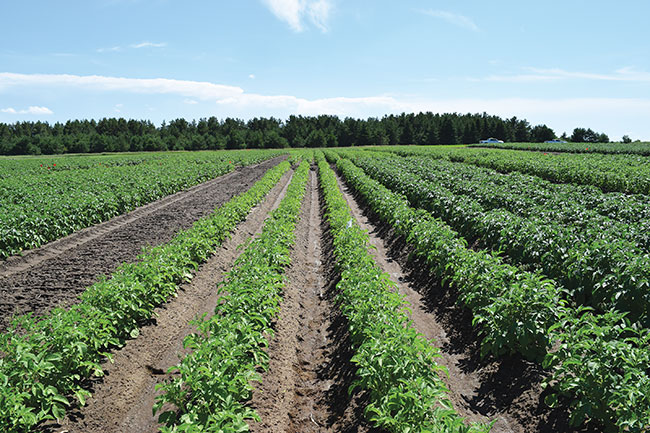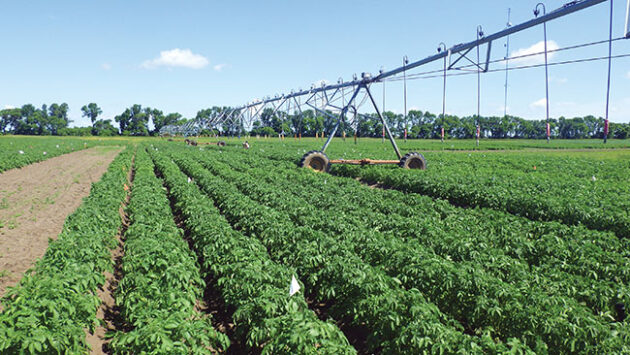
Features
Fertility and Nutrients
Boost growth lag with variable rate products
Researchers are perfecting ways to reverse mid-season plant development slump.
January 24, 2024 By Rosalie I. Tennison
 Nitrogen-deficient plots in early July.
Photo courtesy of zack frederick.
Nitrogen-deficient plots in early July.
Photo courtesy of zack frederick. Potato crops are vulnerable at row closure when the plants begin setting tubers and there is still space for weed and disease pressure. Often growers notice crop development lags during this period. Researchers at the Manitoba Horticulture Productivity Enhancement Centre (MHPEC) in Carberry determined the slump in growth in July is due to nitrogen deficiency. Since most growers diligently apply fertilizers to meet the crop and soil’s needs and often do mid-season fertigation, the group questioned what was happening in the field when crop development slowed. What was the reason behind the slump and could it be rectified to ensure a successful crop?
“We began looking at the time period where the plant needs fertilizer,” explains MHPEC potato research agronomist Dr. Zack Frederick. “We saw good application of nitrogen at the start of the season, but in July the soil was deficient. If fertigation was used in July, the plant was often able to overcome the deficiency.”
However, Frederick became concerned about the timing of application. It is possible in theory, he says, to balance the nitrogen in mid-season when the nitrogen deficiency was observed, but there are variables that need to be considered.
“An unexpected rain could leach all the nitrogen away from the plants,” Frederick notes. “So we needed to find a product that could resist a catastrophic variable such as rain.”
To avoid what they were seeing in the field, the team considered other methods of nutrient delivery. They began by comparing applications of urea and ESN (environmentally smart nitrogen) in small plot trials to see if they could ensure nitrogen would be available to the plant, when needed, but also protected from loss due to environmental factors.
“ESN can stick around longer and can cover the two-week window when the plant may need more nutrition,” Frederick explains about their choice of product.
After four years of research, they have some answers but not enough to guarantee success in a field environment. To garner more information, they are adding SUPERU to the pre-plant and top dress schedule in 2023.
Adequate moisture is a concern for the research team when considering the potato’s growing cycle. In Manitoba, where potatoes are grown most often in sandy soils, Haider Abbas of Manitoba Agriculture’s Crop Diversification Centre in Carberry says water seeping through the sand can take the nitrogen with it causing both moisture and nutrient deficits. By using slow release fertilizer products, he says the issue of nitrogen loss is greatly reduced.
“Our results showed that, when the potato needs small to moderate amounts of nitrogen in mid-growth season and that was combined with a moderate amount of moisture, leaching was minimized and the crop produced on target,” Abbas says. He adds they were able to determine that broadcasting the variable rate product was more effective than side-banding. However, work is still being done to determine the most effective amount of nitrogen and timing of the application.
To help Frederick and Abbas in their 13-acre plots, they began using drone technology to assess the status of the crop. Even though the plots were “flat as a pancake”, according to Frederick, they still relied on 3-D topographical maps provided by a drone. The maps pinpointed areas where fertilizer had been originally applied and also indicated where nitrogen deficiency was occurring.
Going forward, Dr. Nasem Badreldin will introduce hyper-spectral drone technology to map the plots and identify what is seen in the field. The University of Manitoba soil scientist says the information he can gather will benefit growers beyond identifying nutrient deficiency, such as the expected yield and degree of drought. But, it takes time to build the algorithms to ensure accurate information.

An off-site nitrogen study plot where the Manitoba Horticulture Productivity Enhancement Centre conducts its research.
Photo courtesy of Zack Frederick.
“We create a library of colour spectrums that we can use as a signature of a particular problem,” Badreldin explains. “We can use various types of sensors to assess nitrogen concentration along with other biophysical properties in the plant. We monitor soil moisture content and salinity, and we compare our findings with field sampling. What we end up with is a blueprint of how this algorithm can work at least 90 per cent of the time.”
For example, how is nitrogen deficiency interacting with other variables, such as soil moisture or soil texture? While Badreldin’s drone technology has many applications for improving potato production and protection, his research team will be able to explore the cumulative impacts of climate and agricultural practices on soil health and annual potato production in Manitoba.
“While we have been able to replicate problems growers are having, we haven’t been able to pinpoint a solution yet,” Frederick admits. The team compared data using a range of variability but they have yet to determine exactly how much supplemental nitrogen needs to be added mid-season. He hopes by fine-tuning the data they can give growers a definitive guide to follow to achieve their desired results.
“We are slow to achieve our goal because of the type of statistics I am using,” Frederick says. “This is a cautious approach, but it will result in a clear story and rigid proof for large and small scale operations.”
“It’s important to come up with the best possible treatment,” adds Abbas. “We have been sharing our work with producers, but this research is still in its early days and we don’t have something we can guarantee will work in a field situation.”
The algorithm that will be developed by Badreldin’s research team will map a field using a drone to show where an additional bump of fertility is needed and could indicate where variable rate technology could be employed. He assures growers who don’t have access to drone technology that, once developed, the algorithm could be adjusted for satellite imaging. Although, he admits the satellite imagery won’t be as accurate as that provided by the drone due to the differences between the two technologies.
For now, the team knows mid-season applications of slow release products can work, but they are still examining how much is needed and the optimum timing of the application. Ultimately, they want to give growers an answer that is cost-effective and that will result in a crop of potatoes that meets the needs of processors.
Print this page